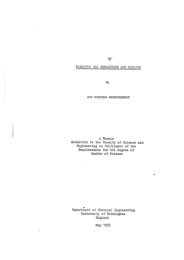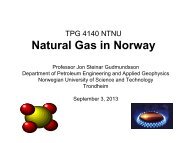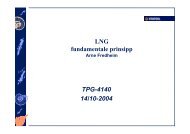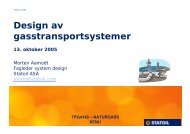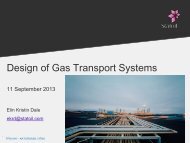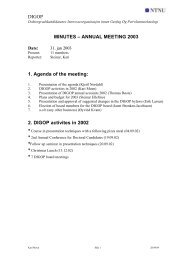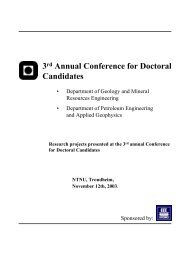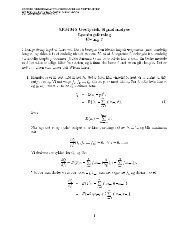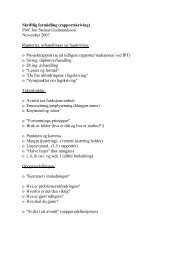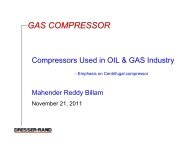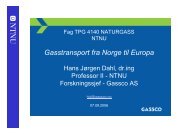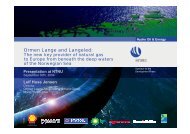NON-PIPELINE TRANSPORT OF NATURAL GAS - NTNU
NON-PIPELINE TRANSPORT OF NATURAL GAS - NTNU
NON-PIPELINE TRANSPORT OF NATURAL GAS - NTNU
You also want an ePaper? Increase the reach of your titles
YUMPU automatically turns print PDFs into web optimized ePapers that Google loves.
<strong>NON</strong>-<strong>PIPELINE</strong> <strong>NON</strong> <strong>PIPELINE</strong> <strong>TRANSPORT</strong> <strong>OF</strong><br />
<strong>NATURAL</strong> <strong>GAS</strong><br />
Jón Steinar Gudmundsson<br />
TPG4140 NATUR<strong>GAS</strong>S<br />
<strong>NTNU</strong><br />
September 12, 2012
Associated Gas Problem<br />
� World-wide, oil fields cannot be developed<br />
unless the associated gas problem can be<br />
solved (”stranded oil”)<br />
� The term ”stranded gas” is used in situations<br />
where the oil/gas field is remote or located in<br />
deep water<br />
� The term ”marginal gas” is used in situations<br />
where the oil/gas field is too small to justify a<br />
gas pipeline
Associated Gas Solutions<br />
Gas-to-Flare (burning)<br />
Gas-to-Well (injection)<br />
Gas-to-Liquid (LNG, MOH etc.)<br />
Gas-to-Wire (electricity)<br />
Gas-to-Tank (CNG)<br />
Gas-to-Solid (NGH)
Non-Pipeline<br />
Non Pipeline Technologies<br />
� CNG Compressed Natural Gas<br />
� GTL Gas-to-Liquid (incl. MOH)<br />
� GTW Gas-to-Wire (DC and AC)<br />
� LNG Liqufied Natural Gas<br />
� NGH Natural Gas Hydrate
Capacity (BCM/year)<br />
CAPACITY-DISTANCE CAPACITY DISTANCE DIAGRAM<br />
10,0<br />
1,0<br />
0,1<br />
Gudmundsson and Mork (2001)<br />
PIPE<br />
100 1000 10000<br />
Distance (km)<br />
ALL<br />
LNG<br />
CNG, GTW, NGH GTL
Khalipour et al. 2009, IPTC 14083
NGH<br />
Size and Technology<br />
Non-Pipeline<br />
Technology<br />
LNG<br />
Syncrude<br />
MOH<br />
Hove et al. (1999)<br />
Nominal Plant<br />
Capacity<br />
3 MTPY<br />
20,000 bbl/d<br />
2500 MTPD<br />
1.6 MSm3/d<br />
Field<br />
Size<br />
2.75 TCF<br />
1.36 TCF<br />
0.54 TCF<br />
0.38 TCF
Norwegian Fields and Plants<br />
Field Name<br />
Ormen Lange<br />
Hammerfest LNG*<br />
Reserves<br />
(gas, LPG, cond.)<br />
400 BCM (=14.1 TCF)<br />
190 BCM (=6.7 TCF)<br />
1 Sm3 = 35.314 ft3<br />
Plant Size<br />
(gas prod.)<br />
20 BCM/year<br />
4.3 BCM/year<br />
* Feed flow 6.9 BCM/year, Products 6.0 BCM/year,<br />
LPG 0.2 MTPY, Condensate 0.7 MTPY (Heiersted 2005)
Natural Gas Resources<br />
BP (2001) and Hove et al. (1999)<br />
� World reserves 150 TCM (=5295 TCF)<br />
� 38% in FSU, 35% Middle East, 9% OECD<br />
and 18% other regions<br />
� 80% new gas fields less than 0.25 TCF<br />
(=7 BCM) in size<br />
� Assuming 20 years, gives delivery<br />
0.35 BCM/year (=12.5 BCF/year)
Natural Gas Monetisation Routes<br />
5 TCF field size, size,<br />
600 MMscfd (=6.2 BCM/year) BCM/year<br />
Non-Pipeline<br />
Technology<br />
MOH<br />
LNG<br />
GTL<br />
Klein Nagervoort (2000)<br />
Global<br />
Demand<br />
30 MTPA<br />
(corrected)<br />
100 MTPA<br />
3,000 MTPA<br />
Plant Size<br />
6 MTPA<br />
4 MTPA<br />
3 MTPA<br />
Plant %<br />
Global<br />
Demand<br />
20%<br />
4%<br />
0.1%
Shell Middle Distillate Synthesis Process<br />
Klein Nagervoort (2000)
FPSO<br />
Overview of Alternatives
FPSO + Methanol<br />
UT-769
Oil<br />
Water<br />
Gas<br />
Choke<br />
Manifold<br />
Water<br />
Separation<br />
Produced water<br />
treatment<br />
FPSO + Methanol<br />
Gas<br />
Discharge<br />
Crude oil<br />
Desulphurisation<br />
Steam<br />
TCR reforming<br />
Crude Oil Storage tanks<br />
Methanol<br />
Synthesis<br />
Stabilisation/<br />
Distillation<br />
Crude Methanol<br />
Methanol Storage<br />
tanks<br />
Grade AA<br />
Methanol<br />
To shuttle<br />
Tanker
54 bar<br />
27 o C<br />
Process, Marine CNG<br />
compress<br />
refrigerate<br />
Discharge - $5%<br />
200 bar<br />
10 o C<br />
15.5 knots<br />
200 bar<br />
5 o C<br />
expand<br />
scavenge<br />
heat<br />
Load - $10%<br />
Sail - $85%<br />
47 bar<br />
5 o C<br />
10 bar<br />
-30 o C
T ariff, $/mmBtu<br />
3.00<br />
2.50<br />
2.00<br />
1.50<br />
1.00<br />
0.50<br />
0.00<br />
Pipe, CNG and LNG, 400 MMscfd<br />
LNG One Train<br />
Ship 1<br />
Ship 3<br />
Ship 2<br />
Ship 1<br />
Compression & Marine<br />
Ship 2<br />
Continental Shelf Pipeline<br />
CNG Conservative Tech<br />
CNG Achievable Tech<br />
Ship 10<br />
0 500 1000 1500 2000 2500 3000<br />
Distance, Kilometers
T ariff, $/mmBtu<br />
4.50<br />
4.00<br />
3.50<br />
3.00<br />
2.50<br />
2.00<br />
1.50<br />
1.00<br />
0.50<br />
0.00<br />
4<br />
5<br />
Pipe vs. CNG<br />
$55,000 per dia.inch.mi, 900 miles<br />
No intermediate compressor stations<br />
30" pipeline<br />
Two 30" pipelines<br />
Standard CNG Carriers (Cons)<br />
0 2 4 6 8 10 12<br />
DCQ bcmy
Hydrate Equilibrium quilibrium Curve urve<br />
Pressure [bar]<br />
200<br />
180<br />
160<br />
140<br />
120<br />
100<br />
80<br />
60<br />
40<br />
20<br />
0<br />
Methane<br />
1 m 3 of hydrate<br />
Natural gas<br />
0 5 10 15 20 25<br />
Temperature [°C]<br />
180 Sm 3 of gas
STANDARDIZED PELLETS<br />
Mitsui Engineering & Shipbuilding
Capital cost of NGH and LNG chains for 400 MMscf/d production and<br />
transport over 3500 nautical miles. Million US dollars mid-1995. mid 1995.<br />
Chain LNG NGH Difference<br />
Production 1220 (51%) 792 (44%) 428 (35%)<br />
Carriers 750 (32% ) 704 (39% ) 46 (6% )<br />
Regasification 400 (17%) 317 (17%) 83 (21%)<br />
Total 2370 (100%) 1813 (100%) 557 (24%)
PIPE, GTL, LNG, NGH<br />
Capex vs. Distance
Images of NGH carriers<br />
Source; 2001-03 JRTT/Phase-1, Conceptual design on NGH carrier
Natural Gas<br />
Water<br />
Natural gas sea transport chain with NGH pellets<br />
NGH formation Storage Tank<br />
Storage Tank<br />
Pelletizer<br />
NGH Carrier<br />
Load Unload<br />
Re-gasification<br />
Powdery Pellets<br />
Pellets to fire<br />
Natural Gas<br />
Water
CONCLUSIONS<br />
1. There is a need for non-pipeline technologies that can capture stranded<br />
gas and transport to market. NGH technology is being developed for this<br />
purpose and is considered an attractive alternative. Several groups have<br />
worked on developing NGH technology world-wide (<strong>NTNU</strong> was the first,<br />
now Mitsui of Japan has pilot-scale production and transport).<br />
2. LNG technology is recognised as the technology of choice for largevolume,<br />
long-distance transport of natural gas. However, about 80% of<br />
the natural gas resources yet to be developed world-wide are too small<br />
for state-of-the-art LNG technology and about one-half of these (40% of<br />
total) are stranded.<br />
3. The cost of transporting stranded gas to market using non-pipeline<br />
technologies has been estimated in the range 1.5 to 3.0 US$ per million<br />
BTU (ca. 1.5-3.0 US$/GJ), depending on the scale of development and<br />
distance to market. CNG and NGH are probably competing in similar<br />
stranded gas situations.



